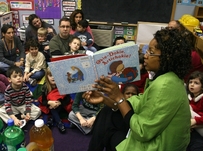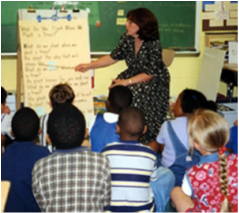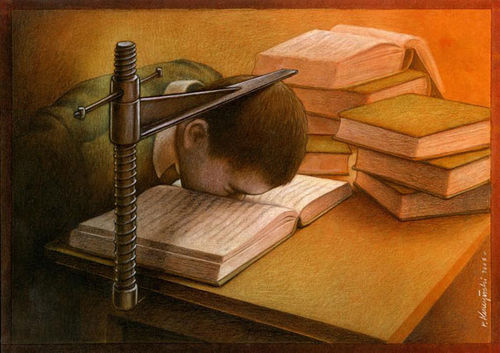 As I prepare for my presentation on actions that can be done with the read-aloud, I am reading the book "Who's Doing The Work? How to Say Less so Readers Can Do More" by Jan Burkins and Kim Yaris. The ideas that are discussed in the book are basically that, the person doing the work is the person who is learning and we want the students doing the learning. The authors have written a section in the book titled: What Makes Read-Aloud Special? I want to summarize this section because I will be using some of this content to help form my presentation in February. The authors list several reasons read-alouds are special.
Teachers have to provide models for how to notice and talk about aspects of text. (Rosenblatt, 2004) The read-aloud is at the beginning of the gradual release of responsibility which makes it easy to assume that the teacher is the one doing all the work. The teacher is responsible for bring the text to the students but you share the responsibility of making meaning from that text with your students. So, how do you implement a read-aloud? It doesn't really matter if you are reading a picture book to your students or if you are reading a chapter book the implementation is the same. We start like we would any lesson, with a plan. For a read-aloud to be successful you need to prepare. You need to select a text. Read the text and consider the points the authors noted.
It's also important for you to select some stopping points, questions (open ended), and look at some vocabulary words to teach and key ideas that might need some discussion as you read to the students. Look for places that may give you the opportunty to model a comprehension strategy, teaching a certain standard, and or lead to discussion of an idea. In order to do this preparation, you must read this book ahead of time. Also in your planning identify places where you think students might need additional support. When you are ready to begin, presentation is everything. Establish a routine of how and where you conduct a read-aloud, It could be on the carpet where students can sit comfortably and close enough to see the illustrations in the text. Read the text with fluency (you are modeling how you would like students to read) and with expression. Be sure to pause at your pre-planned stopping points and listen when you give them opportunities to discuss portions and if they have questions about the text (this means they are thinking as you read and may be correct or may be forming misconceptions) Remember to keep the read-aloud engaging and gauge whether or not the students are still focused on what you are reading. I have been exploring the idea of creating a checklist to use when planning your read-aloud. This checklist would help you effectivly plan for all the possibilites available for the text you have choosen to read that day. As I have been doing research, I have seen several different checklists and rubrics that can help with this intentional planning. You are making memories of enjoyment when you make a read-aloud enjoyable for your students, plus the benefits are widely supported by research; therefore, the more you read-aloud to students, the more these benefits increase. Thank you for reading; I would love your feedback... Burkins, J., Yaris, K. and Moser, J. (n.d.). Who's doing the work?. http://www.flickr.com/photos/wwworks/ (Picture Credit)
0 Comments
Thank you for reading... Painting by Pawel Kuczynski Fisher, D., & Frey, N. (2012). Close Reading In Elementary Schools. The Reading Teacher, 66(3), 179-188. doi:10.1002/trtr.01117  Shared reading -- a concept conceived by Don Holdaway in 1979 as a way to re-create what happens when parents read aloud to their babies at home -- has evolved for classroom use through the years. Shared reading involves enlarged text whether through the use of big books, poster, or projected onto an interactive whiteboard or SMART board so that all students can see, follow along and eventually read along with the lead reader (usually the teacher). Sharon Gill (2006) states: "Shared reading provides repeated readings of predictable texts and poems, building student’s sight-word vocabularies, fluency, and phonics knowledge during enjoyable and successful reading experiences." One benefit of shared reading is that a teacher can focus on targeted skills in a guided way. National Reading Panel results show that teaching phonics in the context of shared reading has the benefit of showing students how phonics knowledge is used in real reading. Since shared reading is usually used with poems and/or short predictive text, it lends it's self very well with teaching onset and rime with our younger readers. Shared reading has also been recomend for use with english language learners and readers who struggle because of the guided aspect and because of the benefit of repeated readings of the text used. Children have the opportunity to interact with and behave like successful reader and teachers can demonstrate strategies usued by successful readers Sharon Gill says. (Gill & Isam, 2011) Five Steps For Shared Reading
Thank you for reading... Gill, S. R. (2006). Teaching Rimes With Shared Reading. The Reading Teacher, 60(2), 191-193. doi:10.1598/rt.60.2.9 Gill, S. R., & Islam, C. (2011). Shared Reading Goes High-Tech. The Reading Teacher, 65(3), 224-227. doi:10.1002/trtr.01028 |
AuthorPearl Garden, Ed.D has completed her dissertation research involving understanding the vocabulary instruction practices of early grade teachers. She has a passion for the new and novice educator, and it is her goal to help educators tackle the achievement gap with her research findings. She will use this blog to share what she has learned in “pearls of literacy”. The ideas come from her dissertation titled “A Content Analysis of the Vocabulary Instruction Habits by Early Grade Teachers”. Archives
January 2024
Categories |

 RSS Feed
RSS Feed